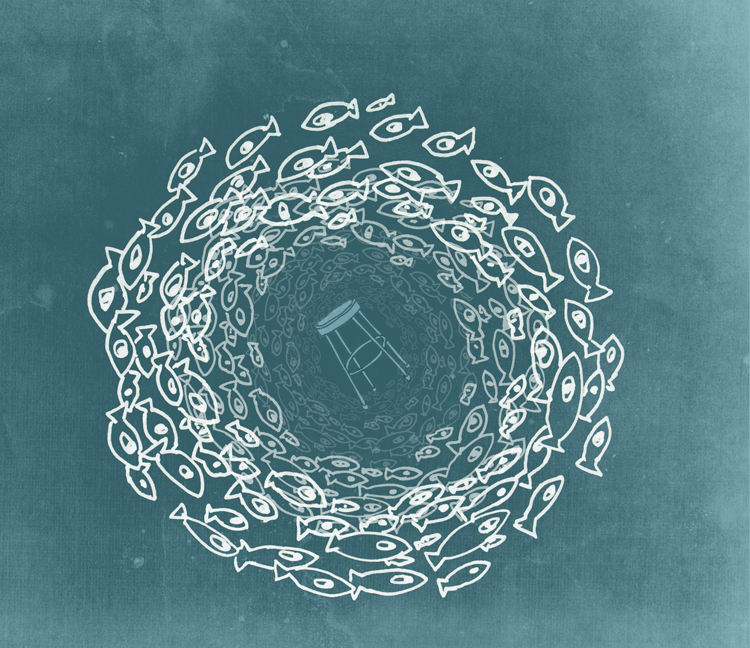At the Yale School of Painting and Printmaking there is a pit. They called it a pit. There were discussions in the pit and they were twice a year, about you, and mandatory.
Some people cried in the pit. They wept because the artist-professors said they held low opinions of the art they had made and—not infrequently, and not only by implication, of them as people—of their intelligence, bravery, craft and work ethic. Since the entire school was watching, along with dozens of students from sculpture and photo, this was very public weeping.
Most did not weep. One student drank heavily the whole time, one told me to play “Get Off Of My Cloud” if it got bad, one painted the most famous teacher being raped by animals and showed it to him, one never had a good crit and is magnificently well off.
It was considered important to have allies when you went into the pit. You would invite your friends—but they weren’t allowed to talk. The professors would talk, and you would talk and you were always outnumbered.
It is no accident that of the three art schools at Yale it was the School of Painting—the most primitive—that enacted the end-of-term critique in its most theatrical, least merciful, and purest form. There are no skills regularly taught in modern art schools—the Pit Crit and its cousins in schools all over the world are the primary ritual of the modern academy: place the artist in the center of a concentric circle whose outermost ring is whatever they felt like making and whose middle ring is their elders, and tell them that they suck.
Some don’t tell you that you suck, but by the time you’re in the Pit they’ve already told you in private so it comes as no surprise. Since there are no grades, the only rewards they will give you are private and very grown-up: nepotism and prizes, but all that comes later. Only the ones that hate you take the Pit as a unique opportunity—they know that if you are breakable, they will break you here. This is American art criticism in its most confrontational and practical form: You are told the things in your art that you thought were surprising aren’t, the things you said weren’t noticed, that even your most reliable moves are wanting or hackwork.
There’s nothing to learn there until you discover that, over the years, they will say this to everyone you know and always have and always will, and this makes it good because then it teaches a lesson:
• some people are wrong
• some of those wrong people nevertheless wield
power
Other lessons you learn in the Pit:
• you survive longer if you talk back
• technology impresses the aged
• some people find it easy to forget that having a
rough day at your Ivy League art school is a good
problem to have
• it is good to have friends
If our most successful contemporary artists seem, whoever else they are, to be consistently detached, media-savvy, sociable, opportunistic, charming, posturing and enamored of the light touch and the critic-proof gesture it is because they have all taken the same class: how to survive a Chechnya’s worth of bullshit. And, by and large, after that they never want to talk about art again.
We have taught our artists, at worst, fear of and, at best, contempt for the process of discussing art—which in turn teaches our critics that our artists at worst cannot (or at best will not) engage them.
Why is it—in an age when everyone from the Secretary of the Treasury to Nicki Minaj responds to criticism at the speed of thought—that when Jerry Saltz says a thing, not even the most secure and successful artist says a thing back? Why, in an age where you can’t swing a dead shark without hitting a podcast about politics, philosophy, comedy or knitting there’s no serious podcast about art? Why can Triple Canopy publish a frenziedly retweeted article about the inanity of academic artspeak, yet everyone keeps shielding themselves in academic artspeak? Why do our most famous artists seem to speak only in hermetic aphorisms? Why are the critics and curators not excited to invite artists to conversations? Why do the documentaries never put the artist and critic in the same room? Why are fine artists the only artists our culture still treats like lab rats?
Because our education has taught us and them that discussion is usually just evaluation, that opinion-as-fact is still in style, that dialogue is a game where you stand to gain no more territory than the work has already bought you and you stand to lose a great deal by risking looking dumb. That your words will be treated as a self-serving defense and theirs are a historical judgment reflecting greater truths. You have the art, they have the brains, and if you are smarter than them then you will have everything and they will have nothing, and they will never be cool with that so shut up and drink.


